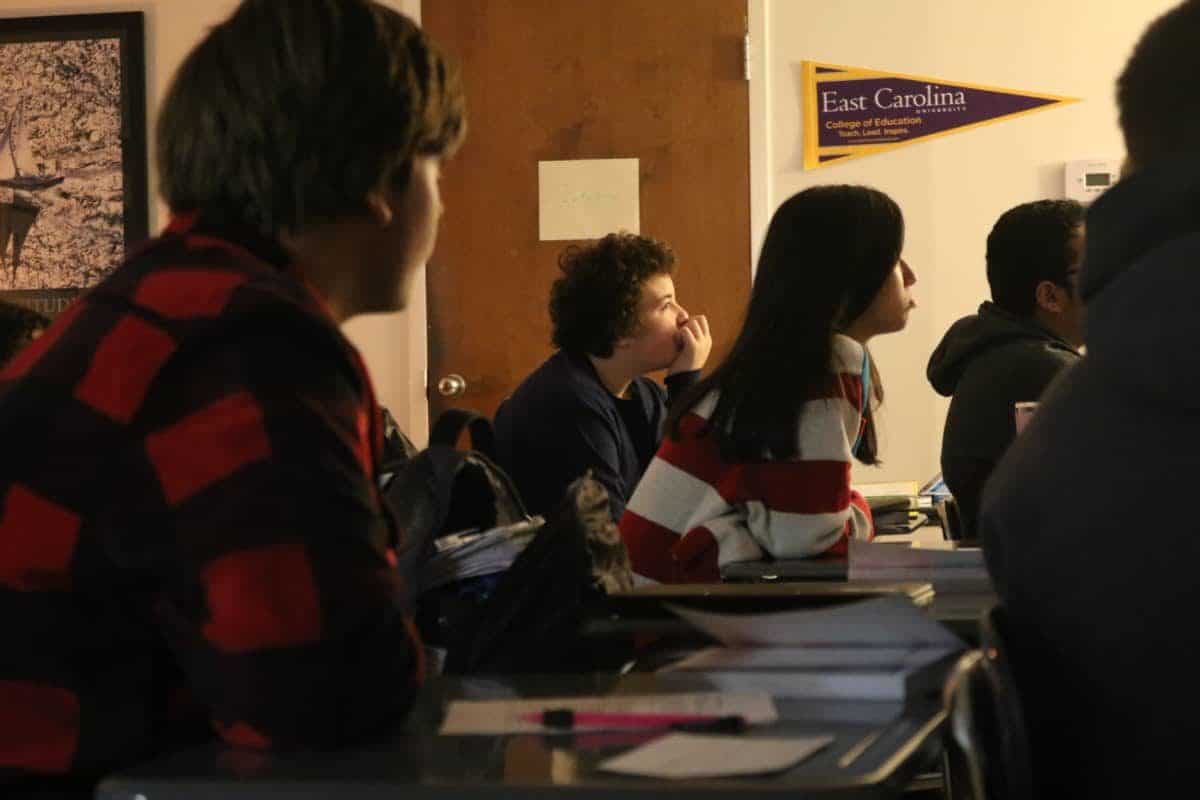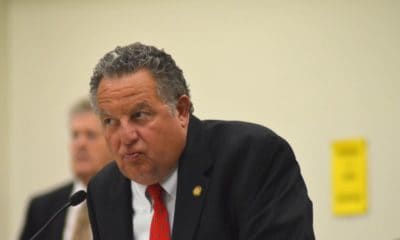
If a provision in the Senate budget makes it into the final spending plan for the next two years, North Carolina’s early college high schools could be facing a reduction in the funding they receive from the state.
Little noticed when the Senate budget passed its chamber, the provision would phase out the supplemental funding the state provides so-called Cooperative Innovative High Schools. The state has 133 of them, 90 of which have early college in their name. Early college high schools allow students to earn college credits while working towards graduation and are paired with institutions of higher education in the area, most often community colleges.
The supplemental funds received by Cooperative Innovative High Schools are above and beyond the traditional funding that schools in North Carolina receive. These schools will still get that traditional funding, but will no longer receive the extra money that, for some schools, enables them to survive.
“The loss of state supplemental funds would push responsibility for supporting early colleges to the local level. Counties with fewer resources — particularly Tier 1 counties — would be hit the hardest,” said Matt Bristow-Smith, the 2019 Wells Fargo North Carolina Principal of the Year and the principal at Edgecombe Early College High School. “Many would have to close their doors. And that means our first generation college students would lose out.”
The provision changes the law to say that supplemental funds for these schools would only be given to a Cooperative Innovative High School in its first three years of operation. The provision also eventually eliminates the supplemental funding for existing schools altogether. Any of the schools that have been receiving this funding prior to the 2017-18 school year would cease receiving it as of the 2021-22 school year. If a school started getting funds in the 2017-18 school year, they would stop receiving them as of the 2022-23 school year.
Bristow-Smith said he uses almost all of these extra funds to pay for his school’s counselor, community liaison, college liaison, college textbooks, and instructional supplies.
“What the Senators don’t seem to understand is that it takes more than just the ADM/FTE dollars to run a school,” he said. “Every Tier 1 school I know spends their supplemental funds similarly to us (personnel, college textbooks, and instructional supplies). To a much lesser extent, we try to squeeze out a few dollars for PD (professional development) when possible.”
This final blow would follow a decrease in funding that these schools have seen over the past few years. Traditionally, each of these schools received $300,000 in supplemental funding. But in 2017, the General Assembly broke up fund amounts between county tiers. Schools in Tier 1 counties, the poorest, received $275,000 annually. Tier 2 got $200,000, and Tier 3 received $180,000.
“We are doing more with less already, but there is a tipping point,” Bristow-Smith said.
This extra funding is essential because these schools are small. Each grade has a cap of 100 students, but they are usually much smaller. The schools are aimed at students who are at risk of dropping out of school, first-generation college students, and students who can use the extra attention and accelerated atmosphere provided by the schools. Ninety-seven of the state’s 115 school districts have a Cooperative Innovative High School.
Students at these schools do well. In 2017-18, 72% of the schools received a school performance grade of A. Only 6.5% of traditional public schools can say the same.
These schools also score better on measures such as high school retention and completion, individual assessments, and high-school drop-out rates. Of the 4,869 students that graduated from a Cooperative Innovative High School in 2016-17, 1,165 graduated with career credentials and 2,214 graduated with a full associate degree.
Researchers from UNC-Greensboro’s SERVE Center, RTI International, and RAND Corporation have been studying the early college model’s impact on student outcomes for over a decade. Their research compares two groups of early college applicants who were accepted by a school’s screening process: those who are then chosen to attend an early college by the luck of a lottery and those who are not chosen by a lottery and attend their traditional public high schools instead. Studies of multiple cohorts of students have found early college students have fewer absences and suspensions and are more likely to earn college credits while in high school, graduate high school, attend a postsecondary institution, and attain a postsecondary credential.
One of those researchers, Julie Edmunds, said she thinks the model is best for students who have potential to succeed in an accelerated environment but have a hard time fitting in or may not have support at home — students who are part of what she calls “the underserved middle.”
“Kids who might otherwise struggle to fit in at a regular high school, but who are interested and who are capable of doing the work, but maybe nobody expected them to do it or that kind of a thing,” Edmunds said. “That’s what I see as the population for whom the model can really make a difference.”
Jackie Harris, principal of Granville Early College, said she worries her students will struggle in a traditional environment that often lacks the level of personalization the early college model provides for its students.
“Those kids get lost in a regular school,” Harris said. “They don’t have time to build those relationships. They don’t have the time to sit down and talk to them. You know, my kids call me. I have their cell numbers, they have my cell number. And you can’t do that when you’ve got 500-600 kids.”
North Carolina Community Colleges President Peter Hans expressed his support for the early college network at RTI’s annual Early College Summit, which hosted around 200 early college educators last week to plan for the upcoming year and collaborate in solving problems. Hans said he is thankful for the partnership between early colleges and community colleges throughout the state.
“As I’m experiencing more and more knowledge of early colleges, the things that come to my mind are, of course, innovation, that North Carolina is such a leader in this space, but also how critical it is to the community college mission that involves certainly affordability, increased completion rates, the opportunity to have smaller class size, the focus on underserved populations,” Hans said. “That is so consistent with what we know this state needs from its educational leadership across the board, that it is truly a privilege to be part of that.”
Sneha Shah-Coltrane, DPI’s director of advanced learning and gifted education, which houses Cooperative Innovative High Schools, said the state has switched how these schools are funded multiple times in recent years. Two years ago, Shah-Coltrane said the state asked her staff to do a cost analysis of CIHS’s. They came back with five critical needs and were open to discuss other ways of funding the schools, like by enrollment instead of economic tier.
“You did the tiers, maybe you want to look at the numbers of kids. You have a school that’s 200 (students) in the same tier with the 500 school receiving the same supplemental funding,” Shah-Coltrane said. “And if it is textbooks, do you need to look at things a little differently? So we’re open to having these types of conversations but we wonder why this… full cut, reduction, without conversations of what could be some other ways of doing this?”
Shah-Coltrane said she wants to communicate two main points: the positive impact the schools have on students and that the supplemental funding is necessary to pay for important aspects of the school, like textbooks and support personnel.
“One is the importance of the program on student lives and the other one is the critical nature of the funding for the schools to continue to do what they do best,” she said.
Education leaders representing the state’s principals and superintendents echoed the importance of early colleges and expressed concerns about the potential cuts in the Senate budget.
Katherine Joyce, executive director of the North Carolina Association of School Administrators, said these schools are essential.
“We need to continue to ensure that every school system has the opportunity to provide an early college,” she said. “It’s critical that our General Assembly continue ongoing funding and support for these very much needed programs.”
She added that if the cuts went through, that would put the onus on counties to provide the missing money. She is skeptical that those resources exist.
“There’s not sufficient county funding to backfill the loss of state funding,” she said.
Bristow-Smith agreed that in places like Edgecombe — a Tier 1 county with the second highest property tax rate in the state — local leaders wouldn’t be able to make up for the money lost from the state.
“It would ask them essentially to raise taxes, and politically they’re not going to do that,” he said.
Shirley Prince, executive director of the NC Principals and Assistant Principals’ Association, said she’s seen first-hand the value of early colleges. When she was a district superintendent, she oversaw the rise of one of the state’s first.
“Of all the improvement initiatives that we instituted, that one was the fastest yielding, most effective, pretty much a guaranteed return on the investment,” she said, adding: “If they’re trying to hurt the early colleges, that’s bad.”
Senate Majority Whip Jerry Tillman, R-Randolph, chairs the Senate’s education appropriations committee, and he said he is working to make sure funding isn’t eliminated.
“I’m not for that particular cut,” he said. “I’m trying my best to get it back.”
When asked if his efforts would pay off, he simply said: “We’ll see.”
The House and Senate are currently well into their negotiations over the differences between the two-year House and Senate spending plans. Rep. Craig Horn, R-Union, a chair of the House education appropriations committee, said the House is firm in its desire to see continued funding for early college high schools.
“The House has long been supportive of early college high schools and the funding of them, and we want to continue to do that,” he said. “We feel that these are a great asset to our state as well as to the family and the kids.”
After the House and the Senate agree upon a compromise budget and the document passes their respective chambers, the budget will go to Governor Roy Cooper. If he decides to veto the spending plan, the Republican-led House and Senate do not have the votes to override the veto without the help of Democratic lawmakers.



